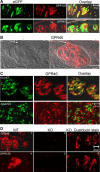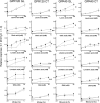Taste preference for fatty acids is mediated by GPR40 and GPR120
- PMID: 20573884
- PMCID: PMC6634626
- DOI: 10.1523/JNEUROSCI.0496-10.2010
Taste preference for fatty acids is mediated by GPR40 and GPR120
Abstract
The oral perception of fat has traditionally been considered to rely mainly on texture and olfaction, but recent findings suggest that taste may also play a role in the detection of long chain fatty acids. The two G-protein coupled receptors GPR40 (Ffar1) and GPR120 are activated by medium and long chain fatty acids. Here we show that GPR120 and GPR40 are expressed in the taste buds, mainly in type II and type I cells, respectively. Compared with wild-type mice, male and female GPR120 knock-out and GPR40 knock-out mice show a diminished preference for linoleic acid and oleic acid, and diminished taste nerve responses to several fatty acids. These results show that GPR40 and GPR120 mediate the taste of fatty acids.
Figures






References
-
- Benton R, Vannice KS, Vosshall LB. An essential role for a CD36-related receptor in pheromone detection in Drosophila. Nature. 2007;450:289–293. - PubMed
-
- Bezençon C, le Coutre J, Damak S. Taste-signaling proteins are coexpressed in solitary intestinal epithelial cells. Chem Senses. 2006;32:41–49. - PubMed
-
- Briscoe CP, Tadayyon M, Andrews JL, Benson WG, Chambers JK, Eilert MM, Ellis C, Elshourbagy NA, Goetz AS, Minnick DT, Murdock PR, Sauls HR, Jr, Shabon U, Spinage LD, Strum JC, Szekeres PG, Tan KB, Way JM, Ignar DM, Wilson S, et al. The orphan G-protein-coupled receptor GPR40 is activated by medium and long chain fatty acids. J Biol Chem. 2003;278:11303–11311. - PubMed
-
- Chale-Rush A, Burgess JR, Mattes RD. Evidence for human orosensory (taste?) sensitivity to free fatty acids. Chem Senses. 2007;32:423–431. - PubMed
Publication types
MeSH terms
Substances
LinkOut - more resources
Full Text Sources
Other Literature Sources
Molecular Biology Databases
